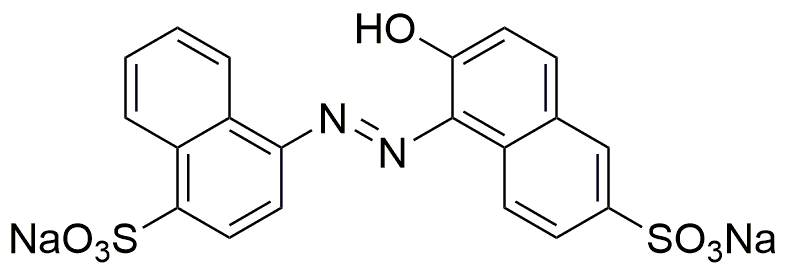Acid red 13 is widely utilized in research focused on:
- Dyeing Textiles: This compound is commonly used in the textile industry to produce vibrant red shades on fabrics, enhancing their aesthetic appeal and marketability.
- Food Coloring: It serves as a food dye, providing a rich color to various food products, which can improve consumer attraction and product differentiation.
- Biological Staining: In laboratories, Acid red 13 is employed for staining biological samples, aiding in the visualization of cellular structures under a microscope.
- Pharmaceutical Applications: It is used in the formulation of certain medications, where its coloring properties help in product identification and branding.
- Research and Development: This compound is valuable in chemical research for developing new dyes and pigments, contributing to advancements in materials science.
General Information
Properties
Safety and Regulations
Applications
Acid red 13 is widely utilized in research focused on:
- Dyeing Textiles: This compound is commonly used in the textile industry to produce vibrant red shades on fabrics, enhancing their aesthetic appeal and marketability.
- Food Coloring: It serves as a food dye, providing a rich color to various food products, which can improve consumer attraction and product differentiation.
- Biological Staining: In laboratories, Acid red 13 is employed for staining biological samples, aiding in the visualization of cellular structures under a microscope.
- Pharmaceutical Applications: It is used in the formulation of certain medications, where its coloring properties help in product identification and branding.
- Research and Development: This compound is valuable in chemical research for developing new dyes and pigments, contributing to advancements in materials science.
Documents
Safety Data Sheets (SDS)
The SDS provides comprehensive safety information on handling, storage, and disposal of the product.
Product Specification (PS)
The PS provides a comprehensive breakdown of the product’s properties, including chemical composition, physical state, purity, and storage requirements. It also details acceptable quality ranges and the product's intended applications.
Certificates of Analysis (COA)
Search for Certificates of Analysis (COA) by entering the products Lot Number. Lot and Batch Numbers can be found on a product’s label following the words ‘Lot’ or ‘Batch’.
*Catalog Number
*Lot Number
Certificates Of Origin (COO)
This COO confirms the country where the product was manufactured, and also details the materials and components used in it and whether it is derived from natural, synthetic, or other specific sources. This certificate may be required for customs, trade, and regulatory compliance.
*Catalog Number
*Lot Number
Safety Data Sheets (SDS)
The SDS provides comprehensive safety information on handling, storage, and disposal of the product.
DownloadProduct Specification (PS)
The PS provides a comprehensive breakdown of the product’s properties, including chemical composition, physical state, purity, and storage requirements. It also details acceptable quality ranges and the product's intended applications.
DownloadCertificates of Analysis (COA)
Search for Certificates of Analysis (COA) by entering the products Lot Number. Lot and Batch Numbers can be found on a product’s label following the words ‘Lot’ or ‘Batch’.
*Catalog Number
*Lot Number
Certificates Of Origin (COO)
This COO confirms the country where the product was manufactured, and also details the materials and components used in it and whether it is derived from natural, synthetic, or other specific sources. This certificate may be required for customs, trade, and regulatory compliance.

